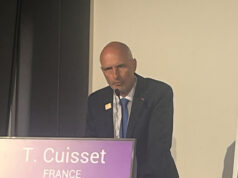
New data comparing the Myval transcatheter aortic valve implantation (TAVI) system (Meril Life Sciences) to contemporary TAVI platforms, have shown that the device continues to measure favourably against its competitor valves.
One-year clinical and haemodynamic outcomes from the randomised LANDMARK trial were shared at EuroPCR 2025 (20–23 May, Paris, France)—comparing the balloon-expandable system to both Sapien (Edwards Lifesciences) and Evolut (Medtronic) valves—demonstrating the non-inferiority of the device against a VARC-3 clinical efficacy composite endpoint comprising all-cause death, stroke and procedure- or valve-related hospitalisation.
The results, presented by Patrick W Serruys (National University of Ireland, Galway, Ireland), also showed comparable outcomes based upon quality-of-life and echocardiohraphic outcomes.
LANDMARK, which took place at 31 centres spanning Europe, New Zealand and Brazil, enrolled a total of 768 patients who were randomised 1:1 to receive a Myval and its later generation Myval Octacor device, or a comparator valve which included the widely used Sapien 3 and Sapien 3 Ultra balloon-expandable devices, or Evolut R, PRO, PRO+ or FX self-expanding systems.
A differentiating feature of the balloon-expandable valve is its availability in a wider range of prosthesis sizes than the comparator valves, with intermediate valve sizing making it possible for physicians to avoid over- or under-sizing the prosthesis based on patient anatomy.
In terms of clinical efficacy, investigators observed a 13% clinical event rate in the Myval arm, versus 13.1% among the contemporary devices, with all-cause mortality virtually identical in the two arms, albeit with a numerically higher number of strokes in the Myval arm, and more hospitalisations among those receiving the comparator devices, both of which were non-significant. Haemodynamic parameters including effective orifice area (EOA), mean pressure gradient (PG), and incidence of moderate or greater aortic regurgitation remained stable and similar across all treatment arms.
“This trial reflects a new era in comparative valve research,” Serruys was quoted as saying in a press release issued by Meril Life Sciences upon the presentation of the study at EuroPCR. “The meticulous design and adherence to VARC-3 standards, including quality of life endpoints, mark it as a pivotal study. The results of the LANDMARK trial represent a meaningful advancement for the global structural heart community—and most importantly, for patients receiving TAVI. The data not only validate the safety and efficacy of the Myval transcatheter heart valve series but also spotlight its adaptability to complex anatomies. This versatility is exactly what clinicians need to deliver precision care across a broad spectrum of patients.”
Alongside the one-year findings of the LANDMARK trial, attendees at EuroPCR heard additional results of the COMPARE-TAVI 1 trial, including complete three-year data collected from patients randomised to receive either the Myval or Sapien 3 and Sapien 3 Ultra platforms.
One-year results of the study, an all-comers trial taking place at centres in Denmark, were first presented at PCR London Valves 2024 (24–26 November, London, UK) and recently published in The Lancet demonstrating the non-inferiority of the device for a composite of death, stroke, moderate or severe aortic regurgitation and valve deterioration.
At EuroPCR 2025, Christian Juhl Terkelsen (Aarhus University Hospital, Aarhus, Denmark) presented the results of a sub-analysis comprising patients enrolled in the study between June 2020 and August 2021 for whom complete three-year data were available, totalling 379 patients.
The study’s primary composite endpoint of all-cause death, stroke, moderate or severe aortic regurgitation or moderate or severe haemodynamic valve deterioration occurred in 27.6% of patients in the Sapien 3 arm, versus 28.3% for Myval.
Terkelson detailed that at three years the incidence of all-cause death (18.2% for Sapien and 18.7% for Myval) were similar whilst stroke occurred in 7.3% of patients compared to 7% of those treated with Myval. Moderate or severe aortic regurgitation was seen in 2.6% of patients treated with Sapien 3 and 6.4% of patients treated with Myval, whilst haemodynamic valve deterioration was recorded in 3.1% vs. 2.7% respectively.










